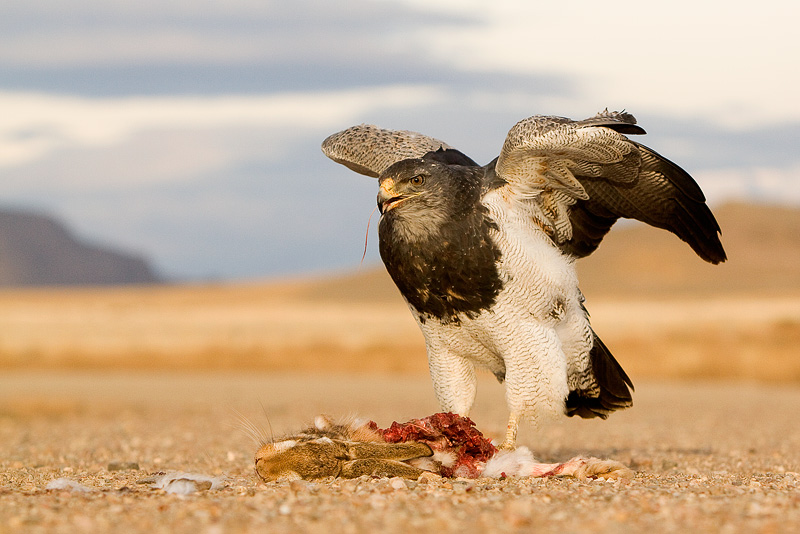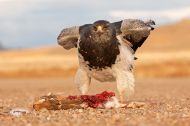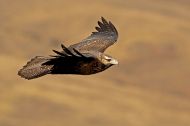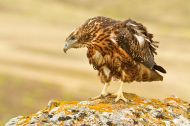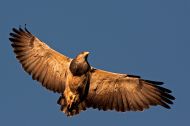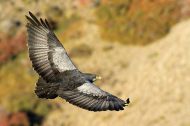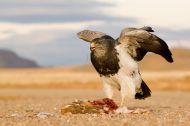Black-chested Buzzard-Eagle
Águila Mora
Geranoætus melanoleucus
Length: 650mm (male) and 750mm (female). Sexes alike. Bill with cere, upper part of maxilla and base of mandible yellow; tip of bill slate grey to black; iris light greyish brown; chin, throat and malar region ash grey; head, breast and back dark plumbeous grey to purple; chest, neck and back feathers show a white speckle at the tip; upper part of forehead whitish; on the nape feathers are white at the base and purple sooty grey at the tip; scapulars, rump, uppertail coverts and rectrices very dark purple sooty grey; outer lesser scapulars pale grey with blackish along rachis and blackish barring; rectrices have terminal white band and middle rectrices are longer than the outer ones; sides of breast, flanks, abdomen and thighs white with fine undulating blackish grey barring; undertail coverts whitish grey with blackish bars and spots; lesser and median wing coverts ash grey with rachis and bars dark plumbeous grey; greater wing coverts, secondaries and primaries ash grey with profuse blackish barring; blackish terminal banding in remiges; median and lesser underwing coverts and axillaries as in flanks; greater underwing coverts dark grey to blackish. Legs yellow. Juveniles: immature with cere, upper maxilla and base of mandible greenish; head, neck and breast buff ochraceous and dark brown at the tip of feathers; back dark brown with ochraceous buff margins; scapulars earth brown; rectrices greyish brown barred blackish brown; lesser and median wing coverts dark brown with apex whitish and ochraceous buff margins; greater wing coverts dark brown with brownish grey barring; primaries and secondaries dark brown with brownish grey barring in outer vexillum; flanks and abdomen dark brown with ochraceous buff margins and barring; thighs and undertail coverts ochraceous buff with dark brown barring. Legs pale green. Juveniles: tail and wing feathers notably longer than adults, transition plumage is darker than first stage plumage as they fledge. Definitive adult phase is acquired four years later.
Adults are unmistakable for their coloration, large size and short tail; however the young can be mistaken at a distance for young hawks but the eagle’s considerably large size rules out any confusion.
Habitat and behaviour: adults mate for life; very territorial, they are found almost invariably at the same nesting sites, protecting an extensive hunting and feeding territory. Juvenals are often found solitary or in groups of two or three along the road from Epuyén to Cholila in northwest Chubut, and also between El Maitén and Ñorquinco, the latter in Río Negro. Not long ago the authors had the chance to spot as many as eight of these eagles together; unfortunately nowadays, albeit still common, their population has decreased noticeably.
Flight is strong and powerful using thermal updrafts to soar high in the sky; they are frequently seen descending on terrific stoops towards prey with hunched wings. This buzzard-eagle preys mainly on mammals such as voles, hares, mountain vizcachas, and rabbits—an easy prey—where these are abundant, and other animals such as skunks, birds and reptiles. To capture large hares, it seizes them with its powerful claws and flies upwards with the prey for 50-80m above ground, then suddenly drops it so that it crashes against the ground; just before the prey hits ground the eagle is already on to it to ensure the catch is killed. It may also scavenge for remains of dead animals such as dead hares and other small mammals that are run over by passing vehicles; these are easy to obtain and fairly abundant. After having filled its crop, it perches on telephone and fence posts to rest. This behaviour, coupled with its tame temperament, has been the reason why population numbers have declined, victim to travellers that use them as targets for shooting practice. An interesting note on their diet has been made by Carlos Mariano Kovacs and Hernán Pastore, both Biology students who in Arroyo Tristeza, near Ñirihuau, northeast of San Carlos de Bariloche, Río Negro, happened to watch them feeding on salmonids. On September 22, 2002, an adult pair of this species was seen at close range, one of them perching on a post while the other was feeding on the ground. On approaching the pair to examine their food, they found it was a rainbow trout (Salmo gairdnieri) that weighed some 3kg on account of its size. As they came closer, the perching eagle flew towards a nearby wood while its mate kept on eating. At 5m or less, this second eagle switched to a defending position instead of flying away. This observation was made during the trout spawning season, it may well be that in shallow waters eagles easily spot them and capture them.
The Black-chested Buzzard-Eagle inhabits all types of environments: on top of low mountains and hills as well as in valleys, plateaus, steppes; also present in cliffs bordering the seashore; in general it is more common in the Andean and sub-Andean regions. The nest is built in ledges in rock walls, slopes, cliffs, also in shrubs or trees, and is constructed with intertwined twigs to make a large platform that is then lined with grass, wool or other soft materials. Clutch size: up to three white eggs with a few brown speckles.
Range: in Patagonia, from Neuquén and Río Negro to Tierra del Fuego, where the race Geranoaetus melanoleucus australis is found; further north it occurs in the west up to Salta and Jujuy; outside Argentina it occurs in Peru, Ecuador, Colombia and Venezuela. The race Geranoaetus melanoleucus melanoleucus dwells in the centre and east of Argentina and also in Uruguay, Paraguay and southern Brazil. Diagnostic features for this race are the white underparts, underwing coverts and axillaries without barring.
Illustrated Handbook of the Birds of Patagonia
Kindless: Kovacs Family
|








